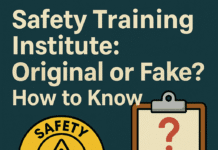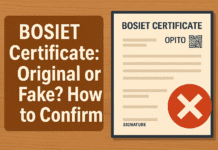
Certified Safety Professional Eligibility: Steps to Becoming a Safety Expert
Introduction
In today’s fast-paced and ever-changing work environments, safety has become a paramount concern for businesses and industries across the globe. To address this crucial aspect, certified safety professionals play a vital role in ensuring a safe and secure working environment for employees and stakeholders. If you’re passionate about safety and aspire to become a certified safety professional, this article will guide you through the essential steps to achieve your goal.
1. Understanding the Role of a Certified Safety Professional (CSP)
Before diving into the certification process, it’s crucial to comprehend the responsibilities and significance of a certified safety professional. CSPs are experts who possess extensive knowledge in safety regulations, risk assessment, hazard control, and emergency response. They play a pivotal role in identifying potential dangers, developing safety protocols, and creating a secure environment within various industries.
2. Education Requirements
Certified Safety Professional Eligibility : To embark on your journey towards becoming a CSP, you must first meet the educational prerequisites. Typically, candidates are required to have a bachelor’s degree in fields related to safety, such as occupational safety and health, engineering, or environmental science. A strong educational foundation ensures that you have the necessary understanding of core safety principles and concepts.
3. Gaining Relevant Work Experience
Apart from academic qualifications, hands-on experience in the safety field is equally vital. Many certification programs demand a minimum number of years spent working in the safety industry before becoming eligible for the CSP examination. The practical experience enables you to apply theoretical knowledge in real-world scenarios, preparing you for the challenges of the profession.
4. Choosing the Right Certification Program
Several organizations offer certification programs for aspiring safety professionals. The Board of Certified Safety Professionals (BCSP) is one of the most renowned institutions that provide the Certified Safety Professional (CSP) designation. Research and select the program that best aligns with your career goals and offers comprehensive training to excel in your chosen field.
5. Preparing for the CSP Exam
The CSP examination is a rigorous assessment of your safety knowledge and skills. It’s essential to invest time and effort in thorough preparation. Utilize study materials, join review courses, and take practice tests to familiarize yourself with the exam format. Remember, dedication and perseverance are key to success.
6. The CSP Exam
The CSP exam typically comprises multiple-choice questions, covering various safety domains. These domains include risk management, safety education, emergency planning, environmental management, and more. During the exam, maintain focus and apply your theoretical understanding to answer each question accurately.
7. Continuing Education and Certification Renewal
Earning your CSP designation is a significant achievement, but it doesn’t end there. To maintain your certification, you’ll need to engage in continuing education and professional development activities. This ensures you stay up-to-date with the latest safety trends and advancements in the industry.
8. Advancing Your Career as a CSP
Once you become a certified safety professional, numerous career opportunities await you. From managerial roles to consultancy positions, your expertise will be in high demand across various sectors. Continue expanding your knowledge and skills to make a positive impact on workplace safety.
9. Conclusion
Becoming a certified safety professional is a rewarding journey that requires dedication, knowledge, and experience. By following the outlined steps and putting in the necessary effort, you can achieve your dream of making workplaces safer and protecting lives. Embrace the challenges, stay informed, and be a catalyst for positive change in the safety industry.
FAQs
1. What does a certified safety professional do?
Certified safety professionals are responsible for identifying potential workplace hazards, developing safety protocols, and ensuring compliance with safety regulations to create a safe working environment.
2. How long does it take to become a CSP?
The time it takes to become a CSP varies based on individual circumstances. It generally involves obtaining relevant education, gaining work experience, and preparing for and passing the CSP exam.
3. Can I become a CSP without a degree?
While a bachelor’s degree in a related field is a common requirement, some certification programs may consider equivalent experience in lieu of formal education.
4. What are the benefits of earning the CSP designation?
Earning the CSP designation enhances your credibility as a safety professional and opens up numerous career opportunities with higher earning potential.
5. How often do I need to renew my CSP certification?
CSP certifications typically require renewal every five years. To maintain your certification, you must engage in continuing education and professional development activities.





















